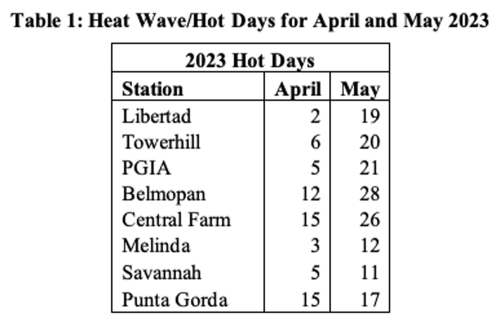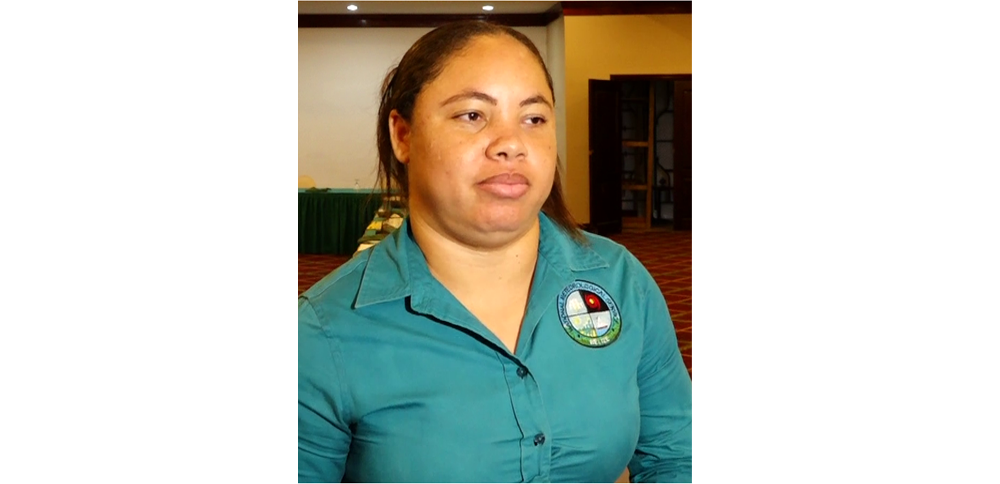Photo: Shenea Young, Senior Climatologist; NMS
This year’s “heat season” started in April, with up to 15 heatwaves already identified.
by Marco Lopez
BELMOPAN, Wed. June 14, 2023
Several daily heat records were broken in May 2023, the National Meteorological Service of Belize (NMS) reported on June 12. Libertad Village in the Corozal District experienced some of its highest daytime temperatures for five days in May, breaking previous records set in 2003, 2005, and 2011. The hot days have been unbearable. The weather stations at the Philip Goldson International Airport (PGIA) and in Punta Gorda broke daily records on May 28. Record temperatures were also recorded in Punta Gorda just days later on May 30 – when Central Farm and Belmopan also reported record temperatures. By May 31, these records at the PGIA and Punta Gorda were once again broken, and a high was recorded at the Melinda Station in Stann Creek.
The NMS press release states that despite the records broken in May, “the historical May maximum extreme temperature values were not broken.”
“Currently, we have been experiencing a high-pressure system, and currently we are in a transition phase. Before, we were in a La Nina phase, which has transitioned to neutral. La Nina typically gives us more rainfall, while neutral it can be either or, and we are currently on path to going into an El Nino phase. For Belize and much of the Caribbean an El Nino phase would result in drier conditions; it should to some extent suppress hurricane development,” Shenea Young, Senior Climatologist at the NMS, explained in an interview yesterday.
The NMS has explained that in the context of temperature records, a “hot day” refers to one where the peak temperature meets or exceeds the top 10% of those in the historical record. Libertad and Belmopan experienced their second warmest May ever, according to the number of hot days; while at the PGIA the fifth warmest May, with a total of 21 hot days, was recorded. At Tower Hill, 20 hot days were recorded. Central Farm had its sixth warmest May, with 26 hot days, almost breaking the overall record for May. In 1995, 27 hot days were recorded in May.
Young explained the differences between hot days and heat waves.
“For us, and most countries, they typically use the 90th percentile, which is just the 10% warmest temperature that has ever been recorded for a particular station and area. So, each station that we have a measurement for across the country has a different threshold for what that 90th percentile would be. So, if the maximum temperature for a particular day or period exceeds what that 90% value is – for instance, Belmopan is around 35 – so any above 35 degrees Celsius would trigger that that’s a hot day; if that value is exceeded for some consecutive days, in some cases at least two consecutive days, then that would be considered a heat wave event,” Young stated.
Toward the end of May, most stations began exceeding their 90th percentile. “That continued from maybe around like the 24th of May up until the 5th of June, and then we had like a break on the 6th before this new heatwave event,” Young explained. And while these hot temperatures are breaking known records, the temperature we actually feel seems much higher than these numbers which have been recorded.
“Belize is very humid, so people would be irritated with the heat or feel uncomfortable with the heat because of the humidity, rather than the actual temperature. So that 101[°F] actually feels like 118[°F]”, Young said.
A low-pressure system is expected to bring some rain this weekend, but the NMS currently is forecasting a below-normal rainy season. While there can very well be periods of rain during the season, the estimated rainfall to accumulate for the next six-month period is lower than normal.
As for the hot, dry days, Young warned, “There are going to be dry spells, and also heatwave events embedded, at least 30 events, during the entire rainy season, up until November.” These drier days are expected to be fueled by an imminent El Nino, which is expected to develop within the coming months, Young noted. The intensity of El Nino may prevent hurricanes from developing in the Atlantic basin, but may result in droughts.
With the forecasted continuation of hot conditions, it will be vital for members of the public to protect themselves. Staying hydrated is the first line of defense. The US Center for Disease Control recommends “sipping regularly, even if you do not feel thirsty.” Moving to the coolest room in the home and possibly spending 2-3 hours of the day in a cool place, like an air-conditioned public building, is recommended. Avoiding the outdoors during the hottest hours of the day, between 10:00 a.m. and 4:00 p.m., if possible, is also an option. Keeping strenuous physical activity confined to the early mornings, between 4:00 a.m. and 7:00 a.m., is also a recommended precaution. In general, it is best to stay in the shade away from the direct sunlight as much as possible.
Special attention should be given to the elderly and persons with disabilities. Heatwaves pose a significant risk to those persons, oftentimes due to the decreased ability to adjust to sudden temperature changes. The National Institute on Aging outlines that elderly individuals are at a heightened risk of heat-related illnesses, and oftentimes dehydration exacerbates the risk. It is crucial that those persons get quick relief when overheated, that they stay well hydrated, and have access to a cool environment during heat waves.
Heatwaves also pose a significant threat to agriculture, oftentimes causing irreversible damage to crops and livestock and large-scale losses for farmers. The heat’s severity and duration, and the timing of the growing season all contribute to the risks of losses. Crops undergo physiological stresses and wilt and die during heat waves, leading to reduced yield and quality – directly affecting the food supply.
And while climate change is not a direct cause of heatwaves, it has surely increased its frequency and severity due to increased global temperatures. In Belize, our coral reef is also at risk of heat-induced mortality caused by the increased temperature. Severe marine heatwaves are more common now as a result of climate change, and this is resulting in an unprecedented uptick in mortality within marine ecosystems, according to the USA’s National Oceanic and Atmospheric Administration (NOAA).
According to the study led by various universities done in association with the NOAA Coral Reef Watch programs, “severe heatwave-induced mortality events should be considered biologically distinct events that cause even more extreme damage than bleaching or mass bleaching on coral reefs. Heatwave mortality events, and rapid reef decay, will increase in frequency as marine heatwaves intensify.”


